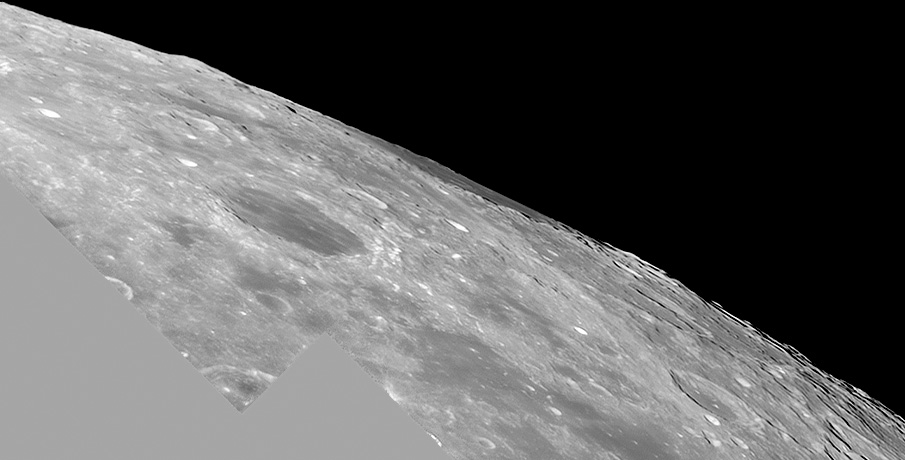|
|
| (5 intermediate revisions by the same user not shown) |
| Line 1: |
Line 1: |
| | __NOTOC__ | | __NOTOC__ |
| | =Rings on the Rim= | | =Rings on the Rim= |
| | + | <!-- Start of content --> |
| | + | <div class="post" id="post-1160"> |
| | | | |
| − |
| + | <div class="storycontent"> |
| − | <div class="post" id="post-1160">
| + | <p>[[File:Humboldtium-Lammel.jpg|Humboldtium-Lammel.jpg]]</p> |
| − |
| |
| − | <div class="storycontent">
| |
| − | <p>[[File:Humboldtium-Lammel.jpg|Humboldtium-Lammel.jpg]]</p>
| |
| | <p><em>image by [mailto:slamm@blueyonder.co.uk Stefan Lammel], Uxbridge, England</em></p> | | <p><em>image by [mailto:slamm@blueyonder.co.uk Stefan Lammel], Uxbridge, England</em></p> |
| − | <p>I love the limb. Only there can you get a perspective of topography that we normally see flattened by our overhead view of much of the lunar surface. In Stefan’s spectacular image of Mare Humboldtianum we see the basin rings almost in profile. Most pronounced is the inner ring which I have [http://www.lpod.org/archive/LPOD-2004-10-30.htm called] the Bishop Mountains. From a high point at the north, the ring traces around the western part of the inner mare pond, and is just visible across the mare on the limb. The outer ring - the Andes Mountains - doesn’t exist around the north end of the basin but is well shown along its western and southern sides. This image shows the different nature of the two rings. The outer ring is largely a scarp - it steps down toward the center of the basin, but doesn’t rise much above the surrounding terrain. By contrast, the inner ring is an arcuate mountain chain that rises above the terrain on either side. This is consistent with impact basin inner rings being equivalents of central peaks in normal craters. </p> | + | <p>I love the limb. Only there can you get a perspective of topography that we normally see flattened by our overhead view of much of the lunar surface. In Stefan’s spectacular image of Mare Humboldtianum we see the basin rings almost in profile. Most pronounced is the inner ring which I have [[October_30,_2004|called]] the Bishop Mountains. From a high point at the north, the ring traces around the western part of the inner mare pond, and is just visible across the mare on the limb. The outer ring - the Andes Mountains - doesn’t exist around the north end of the basin but is well shown along its western and southern sides. This image shows the different nature of the two rings. The outer ring is largely a scarp - it steps down toward the center of the basin, but doesn’t rise much above the surrounding terrain. By contrast, the inner ring is an arcuate mountain chain that rises above the terrain on either side. This is consistent with impact basin inner rings being equivalents of central peaks in normal craters. </p> |
| | <p>[mailto:tychocrater@yahoo.com Chuck Wood]</p> | | <p>[mailto:tychocrater@yahoo.com Chuck Wood]</p> |
| | <p><b>Technical Details:</b><br /> | | <p><b>Technical Details:</b><br /> |
| Line 14: |
Line 13: |
| | <p><b>Related links:</b><br /> | | <p><b>Related links:</b><br /> |
| | [http://www.pbase.com/slammel/moon Stefan’s website]<br /> | | [http://www.pbase.com/slammel/moon Stefan’s website]<br /> |
| − | [http://www.lpod.org/archive/archive/2004/02/LPOD-2004-02-28.htm A wider view]</p> | + | [[February_28,_2004|A wider view]]</p> |
| − | <p><i>You can support LPOD when you buy a lunar book or ANY book from Amazon thru [[LPOD]]</i></p> | + | <p><b>Yesterday's LPOD:</b> [[June 2, 2007|Not Full, not Blue]] </p> |
| − | </div>
| + | <p><b>Tomorrow's LPOD:</b> [[June 4, 2007|The-Moon]] </p> |
| − |
| + | <!-- Removed reference to store page 2 --> |
| − | | + | </div> |
| − | ---- | + | <!-- End of content --> |
| − | ===COMMENTS?===
| + | {{wiki/ArticleFooter}} |
| − | Click on this icon [[image:PostIcon.jpg]] at the upper right to post a comment.
| |




